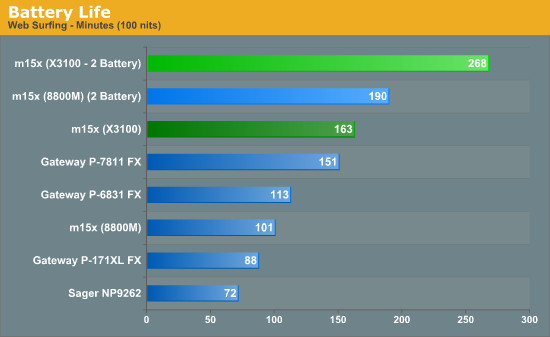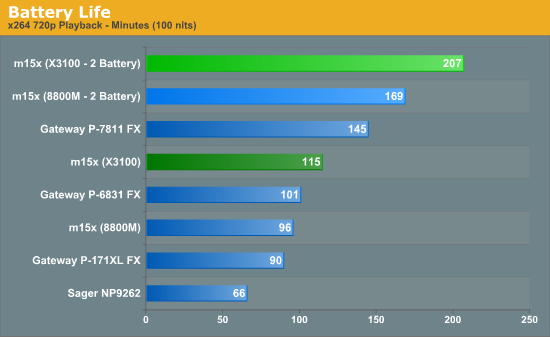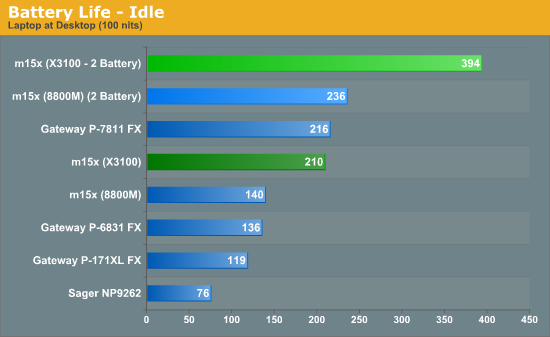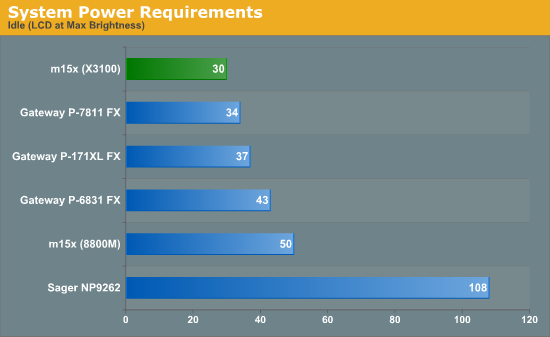Battery Life, Power, and Noise
Cranking out the fastest performance in applications or games is one measure of a good notebook, but honestly it's not the standard by which many users select their laptops. For many, size and weight as well as battery life are going to be the more important areas when purchasing a laptop. You can probably guess that most of these gaming notebooks are going to offer dismal battery life, which is why the BinaryGFX on the Alienware m15x come into play. If you want good gaming performance as well as long battery life, the Alienware m15x is the first notebook we've tested that will satisfy your cravings. Of course, we should start seeing similar laptops as Centrino 2 supports the ability to switch between discrete and integrated graphics (apparently only with NVIDIA discrete graphics chips at this time).
Battery Life
For our battery life testing, we have now switched to running all laptops at around 100 nits brightness. Differences between displays and brightness adjustments mean we are not always at exactly 100 nits, but the range is 90-110 nits in all cases. If you choose to run your LCD at maximum brightness, you may lose anywhere from 10 to 60 minutes depending on the laptop - the latter is mostly for ultra-mobile options while the former is for gaming notebooks. We run for different battery life scenarios: Internet surfing (load several webpages using the wireless adapter every minute until the battery dies), DVD playback, x264 playback, and idle (maximum) battery life. For x264 playback, we copy a 720p file to the hard drive and loop playback using Windows Media Player Classic. We will also include battery life results for Blu-ray playback where applicable - as mentioned earlier, the Alienware m15x failed to function properly when trying to play a Blu-ray disc on battery power. We also tested the Alienware m15x using the optional battery in place of the Blu-ray drive, which significantly improves battery life.




The P-7811 offers very good battery life for a gaming notebook, easily surpassing all of the other laptops... until we switch the m15x to its integrated graphics and add the second battery. The DDR3 and 25W TDP processor definitely help the P-7811, but with two batteries offering 97Whr (compared to 87 Whr for the Gateway notebooks), the m15x does exceptionally well. For office use or Internet surfing, switching to the integrated graphics improves battery life by 40-60%. (We're not quite sure why the improvement varies that much; we would have retested, but time constraints prevented doing so.) Keep in mind that even light use of the laptop should reduce the battery life from our idle scenario, so it is purely a high water mark. The Sager of course offers rather dismal battery life, and it doesn't even seem to enable certain power saving features as idle battery life is barely longer than web surfing battery life.
Power Requirements
Power requirements when a laptop is plugged in don't necessarily reflect power requirements when a laptop is on battery power. In particular, it's important to note that all of these high-end NVIDIA GPUs run at lower maximum clock speed when using the battery power. For example, the Sager NP9262 on battery power ends up running slower than the other notebooks when they're plugged into the wall. Since most users will play games only on wall power, however, these power figures are worth a look.



Most of what we see here is a reflection of what we measured with every life. What's a little scary is just how much power the NP9262 can consume. It uses 108 W just idling at the desktop - and we're only running one hard drive. Load up again and it can easily begin to use more than 200 W of power. If you compare that to some of the gaming desktops we've tested recently, it still uses less power, but the difference between an 8800 GT SLI desktop and the Sager NP9262 isn't all that large. Perhaps that shouldn't be too surprising, considering this is a desktop replacement notebook in every sense.
Noise Levels
We also ran noise testing using an SPL meter at 24" under the same conditions as our power tests.



Somewhat of a surprise is the fact that the Sager isn't actually the loudest laptop of the bunch; in fact under full load it's the exact opposite. A lot of this can be attributed to the fact that it has four giant (relatively speaking) cooling fans, where is the other notebooks get by with two smaller fans that have to spin faster in order to move similar amounts of air. The large chassis on the Sager also helps with dissipating heat. The loudest laptop ends up being the Alienware m15x, which considering what we just said about the Sager does make some sort of sense. The Alienware is the only 15.4" gaming notebook of the bunch, and with a smaller chassis it will need to move that much more air in order to keep temperatures in check.
Speaking of temperatures, we didn't actually take any specific readings but we can say without a doubt that most of these notebooks become uncomfortably hot during extended use. The Alienware m15x is the only one that you might not mind having on your lap, and then only if the 8800M GTX is disabled and you're running on integrated graphics. The exhaust temperatures for all of these notebooks easily surpass 45°C while running games, so if you're wise you want to find a hard, flat surface to use during gaming sessions. Keyboard and palm rest temperatures on the other hand stay below ~35°C, even though we were testing during the summer, so at least your palms won't get burned.










36 Comments
View All Comments
yyrkoon - Friday, August 29, 2008 - link
Yeah, I would not expect my desktop to beat the laptop performance wise(in games), but with what I have for resolution/monitor wise it does perfectly fine for me.It is just that lately, since we are going 100% green energy(solar/wind), or as close to 100% as possible, I have been on this power consumption 'kick'. I would hope that the Intel motherboard with the desktop G45 chipset, and x4500HD would use half of what I am using power wise now with my current desktop, but I suspect that I would have to get the laptop based mini itx motherboard/CPU/memory for it to be truly where I would like to see things power wise. Even only 100W is roughly 8.33 amps off of the batteries on a 12v system : / Depending on how many batteries you have, that can be substantial.
I do realize that gaming on the Intel mini ITX boards would take the back seat because of performance, but it would be a perfect machine for running almost everything except for games. That is, until Photoshop, Illustrator, etc start leveraging the GPU/parallel processing.
Oarngemeat - Friday, August 29, 2008 - link
Good article - but the Alienware is not the first laptop with dual graphics cards like this. Maybe for a gaming laptop, but my Sony SZ is getting close to two years old and can do the same thing. Sounds like it even does things the same way, I have to reboot to switch graphics. I've seen it average at about 50% battery performance increase too.JarredWalton - Friday, August 29, 2008 - link
That's why I say the first laptop *we've* tested. Besides, a midrange (at best) GPU that can be disabled isn't quite as useful as a high-end GPU that can be switched on/off.denka - Friday, August 29, 2008 - link
I liked the article, but I've been looking on the Internet for a review that could tell me how good are ATI's 3650's, of which ASUS seemingly is a fan seeing how they have 5 models for sale on Newegg :)Still looking.
denka - Friday, August 29, 2008 - link
Sorry, must have been a stupid question. Found my answers on www.notebookcheck.netJarredWalton - Friday, August 29, 2008 - link
I've asked AMD to get me a notebook with 3000 series graphics, but no one has been able to do so yet. Outside of the 3870, though, graphics performance will be relatively mediocre. I've got a few midrange notebooks with 9500M/8600M GPUs that I'm reviewing, and one with a Radeon 2600. Performance is around 1/3 of the 9800M GTS in gaming. Many games (GRID, Mass Effect, Assassin's Creed, etc.) need to run at 1280x800 and low to medium detail on such laptops before they can get solid frame rates.fabarati - Saturday, August 30, 2008 - link
The performance of midrange laptop cards go: 9600m GT GDDR3> HD3650> 8600m GT GDDR3> 9600m GT=HD2600 GDDR3>8600m GT DDR2=9500m GS DDR2>HD2600 DDR2. Now there are a few more nVidia cards, just to muddle the waters more, but this should give rough performance estimates. 9500m GS is just a rebadged 8600m GT.On my HD2600 DDR2 I play Assassin's Creed with everything on max at 1280x800. On the other hand, my max is for some reason lvl 3 instead of 4. Solid framerates for one person is not the same as for someone else. Some can't stand below 40, som don't see the difference between 30 and 60. For me, over 25 is quite fluid. It helps that Ass Creed has motionblur. That smooths things up.
Oh, And i've OC'd the Graphics memory a bit. That helps too.
flahdgee - Friday, August 29, 2008 - link
I grabbed an Alienware laptop 3 or 4 years ago, and I expected to be able to game on it. I had the Geforce 6800 Ultra Go put in it and had overheating problems from the start. I had to send it into the company for repairs to the motherboard from various components burning up. Whether I got a defective component somewhere that was tearing it up, I don't know, but it has turned me completely off to laptops, gaming ones in particular.Wolfpup - Friday, August 29, 2008 - link
I'd just be scared off of Alienware-which I am anyway...I'm shocked that even the build quality is garbage. I don't get the point of that 15x thing. Dell's 1730 is SOOOO much better built, and it's higher end, for basically the same price. Those Gateway models seem to be a lot better built too, for at least $1000 less (or worse...)
cheetah2k - Monday, September 1, 2008 - link
Anandtech, you call this a "gaming laptop round-up"??Wheres the almighty Dell 1730 with dual 8800GTX's in all its glory? The little girls to scared to come out to play??
Who wants an Alienware, Gateway or Sagem-blahh??? Build quality and service is just shocking....
Get a grip fellas